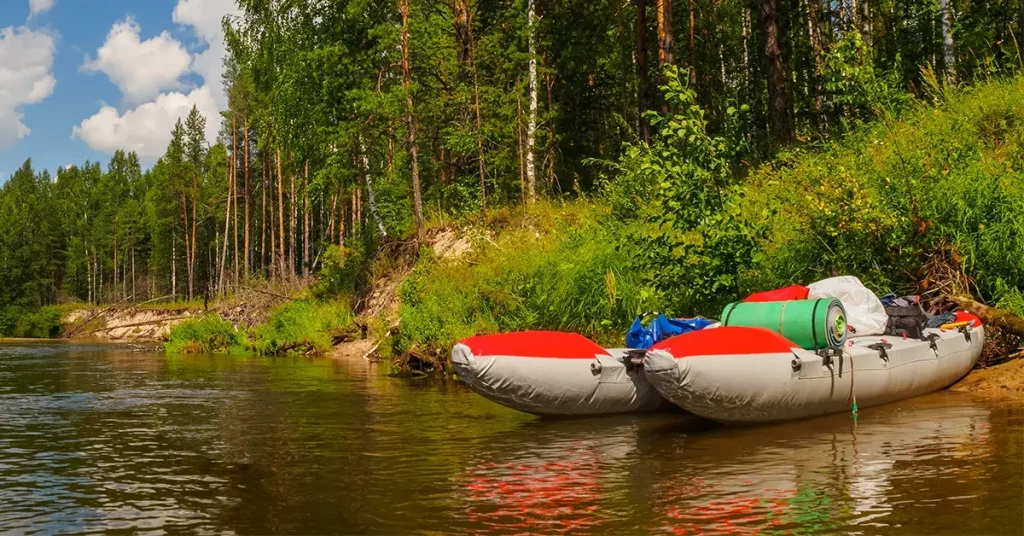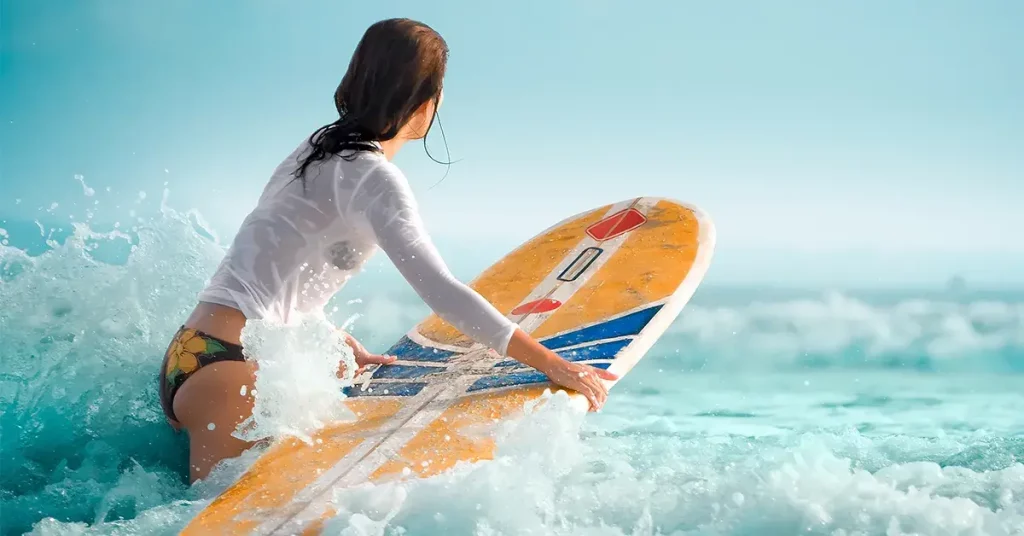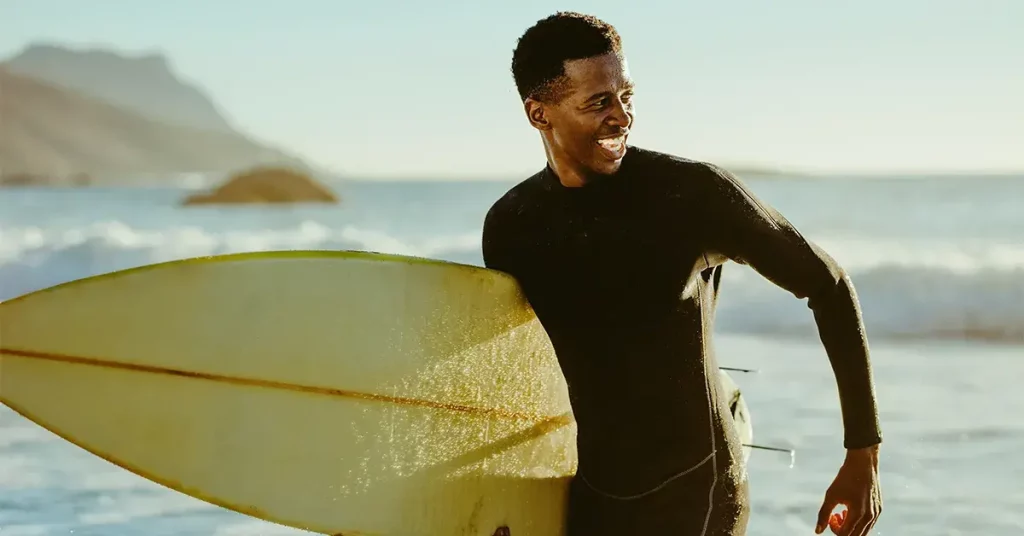If you spent any time researching whitewater craft, you’re bound to come across the catamaran-raft hybrids known as catarafts. These unique looking craft utilize two separate inflatable pontoons connected with a metal frame – which also provides area for seating and storage.
The design differs significantly from traditional self-bailing rafts, and offer several distinct advantages in terms of maneuverability, big water performance, and load-carrying capacity. They’re also generally more forgiving than rafts for beginners and those learning how to row in whitewater.
I’ll break down some of the best catarafts for different use cases available now, and explain what you need to consider to find the right one for your particular needs.
Quick Answer: 5 Best Catarafts
- Best Overall: AIRE Wave Destroyer 14ft Cataraft
- Best Touring/Expedition Cataraft: NRS 16′ Kodiak Cataraft
- Best Solo Cataraft: Star Kima 13 Cataraft
- Best Fishing Cataraft: Outcast Fish Cat 4 Deluxe
- High pressure Floor Cataraft: Star Slice 11 Paddle Cataraft
Why a cataraft?
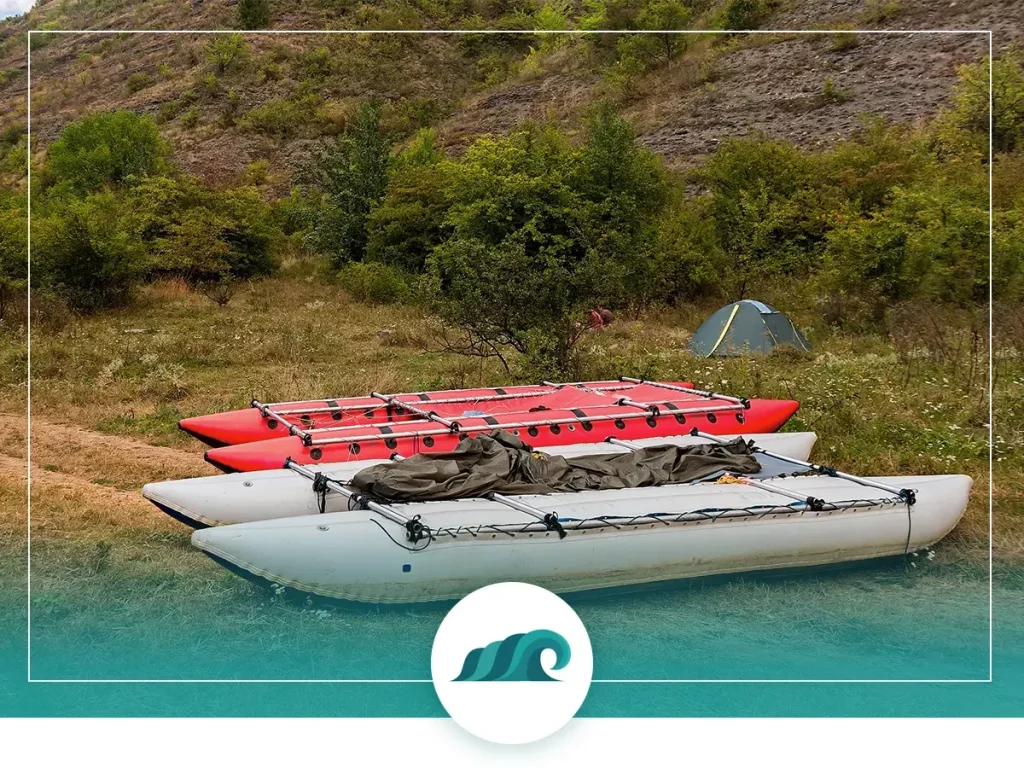
As quality whitewater inflatable craft aren’t cheap, you’ll want to consider a few things carefully before making a decision. For most people, the choice will come down to either a traditional raft or a cataraft.
Both have their relative strengths and weaknesses, so consider how you plan to use your raft for the most part, and what makes the most sense for your environment.
Catarafts
Catarafts generally offer superior maneuverability than rafts, making them nimble and easier to turn on dime. They’re also very forgiving, making them ideal for beginners – and good boats to learn how to row whitewater with. They’re also highly customizable, allowing you to mount different frames and add-ons to them to suit your needs.
As far as cargo space goes, a fully decked out cataraft will hold more than a raft of equivalent length. A 14-foot cat with decks added to the front and rear can hold more than a 14-foot raft, although you’ll need to be more judicious in how you pack them to avoid unbalancing the craft.
Cataraft tubes are wider and sit higher in the water that rafts, so they can straddle over rocks and other obstacles that would slow down most rafts. This also means they’ll catch the wind a little more than rafts. If you’re interested in mounting an outboard motor, catarafts will be easier to do this with than most rafts.
On the negative side, catarafts don’t have as much passenger space as rafts, and are harder to move around in. They also don’t come standard with any flooring, so anything you drop inside them is likely lost for good – although you can install aftermarket flooring in them to prevent this.
Rafts
Rafts offer a good mix of maneuverability, weight capacity, and passenger space. As they sit lower in the water, weight distribution is less of an issue, and they won’t catch the wind to the same degree.
Beyond having significantly more room for passengers to sit on the perimeter tubes and thwarts, rafts allow you to move around freely inside them. They also can either be paddled or rowed, whereas cats can only be rowed. They’re also more kid-friendly than catarafts.
Rafts also have several downsides. They have more surface area in contact with the water, which makes them less maneuverable. Their large bottom surface can snag or stall in rapids that catarafts would punch through. They’re also easier to get caught up on rocks or logs that catarafts would straddle.
Generally speaking, rafts are more expensive than comparable catarafts, although this isn’t always the case – especially when you consider add-ons like flooring and cargo bags.
Best Overall: AIRE Wave Destroyer 14ft Cataraft
Aire makes some of the best-quality rafts on the market, and this gorgeous-looking whitewater cataraft is no exception. It tracks well, turns on a dime, and surfs through the scary stuff with ease. It’s designed for thrill-seeking whitewater use in rapids up to technical class 5 rapids – as well as multi-day trips when you’re packing light.
Like the name suggests, the wave destroyer’s dramatic 33” bow and stern rockers allow the boat to power through steep drops, big waves and monster holes. The 22-inch diameter tubes and 14-foot overall length makes it the ideal size for two people to run rapids or cruise for shorter multi-day trips. Like other high-performance cats, it will work best when not fully loaded with gear.
Internal urethane Aire cells provide improved strength and durability, while integrated strip pockets protect your boat from the frame. Leafield B7 valves provide dependable and user-friendly inflation, and a repair case also comes included just in case.
Like other catarafts, the frame and accessories are sold separately, so you’ll need to pick those up before you can hit the water.
Key Features
- Tube Dimensions: 14-foot long, 22-inch wide
- Ideal for high-performance whitewater, day-trips, and short multi-day outings
- Dramatic bow and stern rocker for excellent maneuverability
- Urethane Aire cells and Leafield B7 valves
- Four inflatable chambers per tube
- 10-year warranty
- Repair kit included
See Pricing On:
Best Touring/Expedition Cataraft: BRIS 15.4 ft. Inflatable Boat
When it comes to catarafts, the BRIS 15.4 ft. Inflatable Boat is of premier quality from top to bottom. Crafted out of PVC fabric with polyester support for enhanced durability, this boat gives users peace of mind when taking on waves or going whitewater fishing, touring and more.
Its bottom reinforcement system offers superior resistance to tearing, tension, and breaking, making it an ideal choice for both expeditions and leisurely paddling.
The BRIS inflatable boat is designed to withstand even the most extreme conditions, with steel-reinforced seams that are heat welded to ensure they stay perfectly sealed, quadruple overlap for maximum strength, and unmatched durability even in salt water or humidity.
This boat also features a marine plywood transom that is perfect for mounting an outboard motor to explore and discover even more. The double layers of fabric on the bottom of the boat protect it from sharp rocks and abrasive sands, and its deep V-keel makes for easy planning.
With five individual chambers to keep your belongings safe and secure, a one-way drain valve with plug, a built-in oarlock for easy rowing, and both interior tie-down stainless steel D-rings as well as large tow stainless steel rings on the bow and rear tubes, this is an ideal cataraft to take along in any water adventure!
This inflatable boat includes all you need to get out on the water, including a repair kit, two aluminum oars, a carrying bag, and a foot pump.
Key features
- Crafted out of PVC fabric with polyester support for enhanced durability.
- Steel-reinforced seams that are heat welded to ensure they stay perfectly sealed.
- The marine plywood transom is perfect for mounting an outboard motor so that you can explore and discover even more.
- Five individual chambers to keep your belongings safe and secure.
- One-way drain valve with plug.
- 30 days money-back guarantee.
- Repair kit included.
See Pricing On:
Best Touring/Expedition Cataraft: NRS 16′ Kodiak Cataraft
If you’re looking for a cat that’s got the cargo capacity to handle multiple rowers for longer multi-day trips, this is the one for you. With giant 16-foot 28-inch diameter tubes, the craft sits high in the water and will keep you nimble even when under heavy loads. While it’s meant for cruising, it will still blast through the big stuff with ease.
Extended wear patches on top of the tubes allow for frames up to 10 feet long. This means you’ll have enough capacity to seat 2 to 3 people plus enough gear for lengthier multi-day trips comfortably. The heavy duty Pennel Orca material is super abrasion-resistant, while sixteen 2” stainless steel D-rings provide an excellent anchor system for your frame.
Each tube features 3 inflatable chambers, so you’ll have maximum security in case something goes wrong. Leafield C7 valves ensure easy and dependable tube inflation and deflation.
All in all, when you want a cataraft with maximum cargo capacity for long-distance cruising, the NRS 16’ Kodiak is about as good as it gets.
Key Features
- Tube Dimensions: 16-foot long, 28-inch wide
- Ideal for hauling heavy loads, multi-day trips, and long-distance cruising.
- Continuous curve tubes provide excellent capacity, maneuverability, and a smooth ride.
- Leafield C7 valves for easy inflation/deflation.
- Three inflatable chambers per tube.
- 10-year warranty.
- Repair kit included.
Best Solo Cataraft: Star Kima 13 Cataraft
Agile, lightweight, and well-built, this highly maneuverable cataraft makes a great choice for whitewater day outings or carrying light gear for an overnight trip. At 13’ long and 22” wide, the highly rockered inflatable tubes are exceedingly maneuverable and quick in the water, enabling you to blast through holes and fly over waves effortlessly.
The abrasion-resistant PVC material uses state-of-the-art seam welding to create a tube with enhanced longevity, air retention, and performance. Three inflation chambers ensure your stay above water in case a puncture occurs.
An extra layer of PVC on top of the tubes adds an additional layer of protection from frame wear, while high-end Leafield C7 valves ensure you’ll have no issues with inflation or deflation. Eight stainless D-rings on each tube provide you with plenty of tiedown options for your frame.
Star backs up the cataraft with a decent 5-year warranty, which is less than some of the more expensive models. A repair kit also comes included in case you need to make repairs in the field.
Key Features
- Tube Dimensions: 13-foot long, 22-inch wide
- Ideal for whitewater day outings or overnight trips with light gear
- Highly rockered continuous curve tubes for whitewater performance
- Capable of handling up to class V rapids
- Leafield C7 valves with three inflatable chambers per tube
- 5-year warranty
See Pricing On:
Best Fishing Cataraft: Outcast Fish Cat 4 Deluxe
While most catarafts can be setup for fishing use fairly easily, the Outcast Fish Cat comes pre-rigged with everything you need to start river fishing out of the box. Unlike most catarafts, the aluminum frame and seats come included, so you won’t need to purchase these separately. It’s large enough to fit 2 anglers comfortably, with plenty of room for fishing or overnight gear.
The tough aluminum frame has two parts, with the front part being removable when you want to convert the craft into a single-person expedition raft. The 13-foot long, 20” diameter tubes are fast and agile in the water, and can support up to 750 pounds.
The rugged PVC material is built to withstand skinny, rough water conditions, so there’s no need to baby this craft. The 11-piece aluminum frame is east to assemble, and comes with two 8-foot oars and an anchor system. An optional motor mount (not included) allows you to attach an outboard or trolling motor directly to the frame.
Key Features
- Tube Dimensions: 13-foot long, 20-inch wide
- Aluminum frame, seating, oars, and anchor system included
- Enough room to fit two anglers plus plenty of fishing/overnight gear
- Front section of frame can be removed to create 1-person expedition craft
- Motor mount optional
- 5-year warranty
High-pressure Floor Cataraft: Star Slice 11 Paddle Cataraft
Unlike most Catarafts, this lightweight craft features a raised self-bailing high-pressure floor that doesn’t require a solid frame to setup. The floor is raised 6” above the tubes, so like a traditional cataraft, only the tubes come in contact with the water.
The design creates a responsive and aggressive cat that punches through whitewater with ease, and is highly maneuverable in the water. A high-pressure 3” drop-stitch deck attaches to the self-bailing floor, creating a stable platform for 1-2 paddlers.
Self-draining zippered compartments in the front and rear give you ample storage space for any gear you don’t mind getting wet, while five separate air chambers ensure you’ll stay afloat in case of a puncture. High-end Leafield C7 valves ensure smooth inflation and deflation, while ten stainless steel D-rigs assist with strapping down gear, running lines or rigging a small rowing frame.
Key Features
- Tube Dimensions: 11-foot long, 20-inch wide
- Lightweight, high-volume, frameless design excels in rapids
- Self-bailing floor with high-pressure drop-stitch deck
- Built in front and rear zippered storage pockets
- Leafield C7 inflation valves
See Pricing On:
How to pick the right cataraft
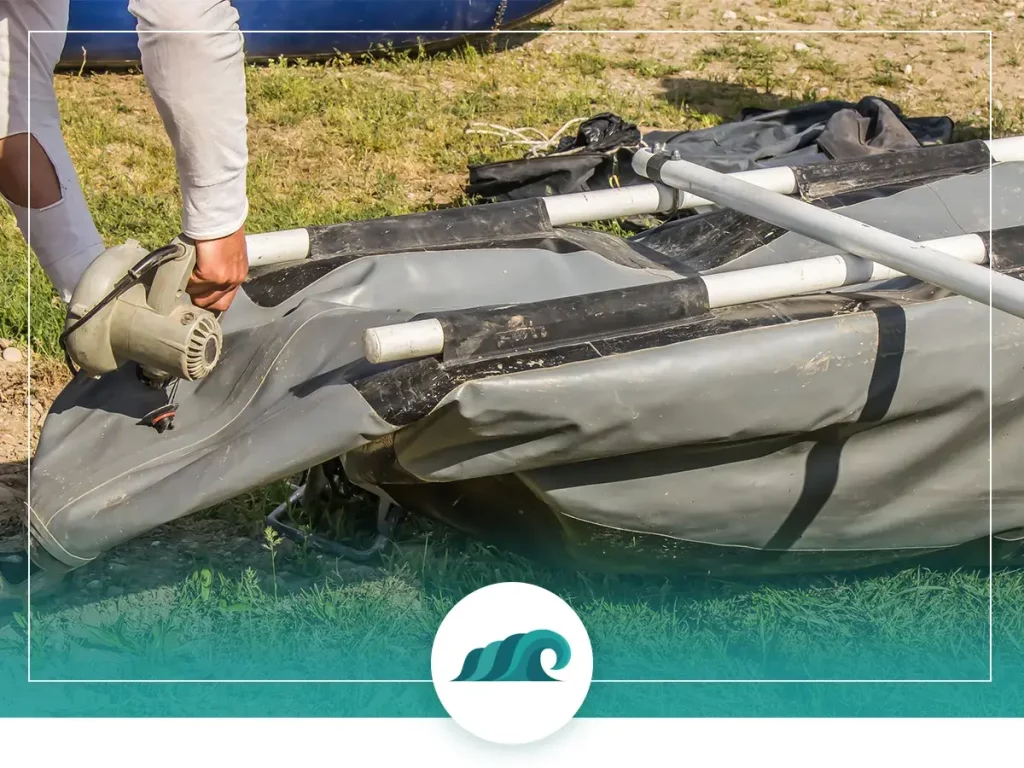
Catarafts differ substantially in terms of carrying capacity, performance, and maneuverability. They also aren’t cheap – they’re made from some of the most durable materials on planet, and need to withstand the rough and tumble environment of whitewater rivers.
Whenever you’re dropping a significant amount of change on a watercraft, you’ll want to make sure it fits your needs and requirements. Let’s take a look at some of the key features to be aware of when choosing the right cataraft for you.
Materials
There are three main material types used in most rafts and catarafts: PVC, Urethane, and Hypalon.
Urethane is slick and slips nicely over rocks. It’s highly durable, lightweight, and makes an excellent material for most rafts. It’s more expensive than PVC, and is fairly difficult to actually repair in the field.
PVC is the least expensive material, and depending on the manufacturer, can be prone to damage. They tend to be mass produced, so if you’re going to go with PVC, you’ll want to make sure it’s a trusted name brand.
Hypalon has a long lifespan, is highly abrasion and puncture resistant, and is easier to roll up than PVC. It’s fairly expensive, and may go by a variety of different names depending on the manufacturer. NRS, for example, calls their proprietary Hypalon fabric ‘Pennel Orca’.
There are also many hybrid materials where manufacturer’s combine several materials together to offer a superior mixture of durability, light weight, and performance over rocks.
Tube Dimensions
Cataraft tube dimensions are another important factor to consider when making a decision. Tube length and diameter determine how large of a frame can be mounted to them, and also how much carrying capacity they’ll have.
Longer, wider cataraft tubes displace more water allowing you load more people and gear onto them. These tubes are typically found on touring, expedition and fishing watercraft, where a heavier load capacity is a necessity.
Shorter, narrow tubes don’t offer the same level of carrying capacity, but are light and highly maneuverable in the water. These are typically found on whitewater focused craft.
Rocker
Similar to surfboards and skis’, rocker refers to the curved portion between the cataraft front (called the kick) and the flat area below. The more rocker a craft has, the more maneuverable it will be, but a large rocker will also decrease stability – as less surface area will come in contact with the water.
Less rocker will increase stability and place you closer to the water, but won’t be as nimble or maneuverable in whitewater.
Use Case
How you plan to use your cataraft will have a major impact on your decision-making process. If you plan on doing multi-day fishing or hunting trips with multiple passengers, you’ll need a larger, more stable craft than if you’re only planning on day outings. These craft are typically 14 – 16 feet long and up, and feature wide diameter tubes for loading down with heavy gear.
Catarafts geared more towards whitewater playboating typically feature aggressive rockers, less carrying capacity, and enough room for 1-2 rowers only. Many of these craft are in the 12 to 13-foot length range.
As catarafts are highly versatile, they often be rigged using different sized frames with a number of different add-ons and accessories depending on your preferences. This gives you a good amount of flexibility when it comes to setting up your cat.
Frame
Generally speaking, you’ll need to purchase the aluminum frame separately when picking out a cataraft. Most only come with the tubes – meaning you’ll need a frame to complete the craft.
Like catarafts themselves, frames differ significantly in terms of size, function, and performance. You’ll want to match your cataraft tube’s length with the length of the frame. Most tubes will come with a maximum frame length, so pay attention to this when picking out a frame.
Good frames are highly customizable, with plenty of crossbars and mounting space for all the accessories you could possibly need.
Check out some of the top frames available now:
- Universal Frame: NRS Universal Raft Frame
- Fishing Frame: NRS Cat Fish Frame
- Multi-Day Frame: NRS Fat Cat Frame
- Compact Frame: NRS Alley Cat
Additional Gear
When outfitting your cataraft, your level of customization is only limited by your imagination and budget. You can easily transform your cat into a fully decked out fishing expedition craft with a little work. Let’s take a look at some of the best add-ons and modifications you can add to your cat.
Flooring: Many folks like to add some type of flooring to their cataraft frame. This is particularly useful for adding coolers, dry boxes and other cargo, as well as for standing on while you’re fishing. Flooring also helps prevent you from accidentally dropping things through the frame. Check out the NRS Cataraft Cargo Floor for a well-made modular flooring solution.
Dry Box: If you’re planning on partaking in longer expeditions, a good dry box is a must-have. These cargo containers use double-layer waterproof gaskets to keep your gear bone dry no matter how drenched the box exterior gets. Check out the FrontierPlay Dry Adventure Box for an ideal dry storage option.
Oars & Oar Locks: A cataraft isn’t much good without some form of propulsion. Oars are needed to row and maneuver through the water, while oarlocks keep your oars locked in place and minimize friction while rowing. Some frames will come with built in oarlocks, while more barebones frames will require you to purchase them separately. Check out the Cataract SGG Raft Oar Shaft and Cataract Oar Magnum Blade for some of the best-quality cataraft oars on the market.
Leg/Thigh Bars: Leg and thigh bars allow you to stand up while casting and fighting fish, even in rough, fast moving water. They give you a sturdy support bar to lean on while standing up, so you won’t go flying overboard in case you hit a rough patch of water. Check out the NRS Fishing Frame Y Thigh Bar for a great Y-shaped thigh bar.
Maintenance and Care for Your Cataraft
A cataraft is an extremely versatile and reliable way of getting out on the water, but as with any craft, it is important to keep up with regular maintenance and care to ensure that your cataraft remains in tip-top shape.
Here are some tips to help you get the most out of your cataraft:
Inspect the Cataraft Regularly
It’s essential to inspect your cataraft regularly for signs of damage such as tears or cracks in the fabric, worn or damaged hardware, or any other problems that could affect its performance. Perform these inspections before each use so you can spot any potential issues early and address them before they become more serious.
Repair Damage Right Away
If you detect damage during your inspection, it’s important to repair it right away. Depending on the severity of the damage, this may mean taking your cataraft into a shop for professional repairs or simply patching up minor tears yourself. Don’t wait too long — small issues can quickly turn into larger ones if left unaddressed.
Keep It Clean
Cleaning your cataraft after each trip is the key to keeping it looking its best and ensuring that no dirt or debris builds up on the surface over time. Use a mild detergent and soft brush or cloth when cleaning, taking extra care around any seams where dirt might gather. Rinse off all soapy residue afterward with clean water.
Store Your Cataraft Properly
Store your cat rafter properly when not in use. Be sure to thoroughly dry any moisture off the surface first if necessary, then fold (not roll) your raft before storing it in a cool, dry place away from direct sunlight. Always keep items like knives, tools, and netting away from sharp edges so they don’t cut through the material over time.

